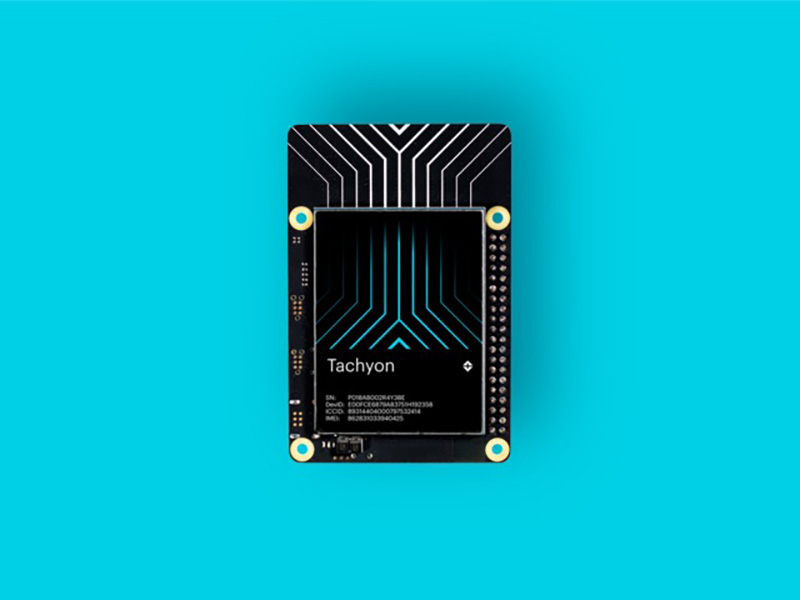
Particle Tachyon by Particle
Tachyon is a 5G-connected single-board computer (SBC) that takes the technology inside a modern smartphone and packs it into a Raspberry Pi form factor to power portable and remote computing devices. With a powerful Qualcomm Snapdragon SoC, an AI accelerator, and Particle’s edge-to-cloud IoT infrastructure, Tachyon combines all of the edge computing power, connectivity, and software necessary to embed intelligence into anything, anywhere.
At the heart of Tachyon is the Qualcomm Dragonwing QCM6490 — an SoC that takes the power of a Dragonwing and packages it into an IoT-friendly package with upstream Linux support and a 10-year longevity guarantee.
The Dragonwing QCM6490 features an octa-core Qualcomm Kryo CPU, making Tachyon one of the most powerful single-board computers on the market. In addition, Tachyon has a Qualcomm Adreno 643 GPU and a Qualcomm Hexagon 770 DSP containing an AI accelerator capable of delivering 12 TOPS. It can drive 4K displays, consume high resolution video from two cameras, and run powerful AI/ML models to detect objects in video streams, classify sounds in audio streams, and process language.
Tachyon is capable of doing real work wherever you deploy it — at home, at work, or far afield.
Upgrading the processor is only the beginning. We want to make it easy to deploy these things anywhere, and that means blazing-fast 5G connectivity.
Not only does Tachyon come with 5G connectivity operating at up to 2.5Gbs (with LTE fallback and an integrated custom cellular antenna!), but it comes pre-loaded with Particle’s embedded EtherSIM+ with free cellular telemetry and an optional low-cost data plan (more details below).
Sending gobs of data? Don’t worry, Tachyon has a Wi-Fi 6E connection for blazing fast connectivity over your Wi-Fi network, again with a built-in antenna.
Tachyon is a powerful computer in its own right, but it really comes alive when connecting displays, cameras, sensors, and other peripherals.
But where are the usual big blocky USB and Ethernet ports, you ask? Well, don’t let the fancy cellular antenna make you think we forgot about wires and cables. Tachyon has dual USB-C connectors, automatically operating in both device and host modes depending on the attached cable. One of the USB-C 3.1 connections supports Display Port Alt Mode, which means you can connect Tachyon directly to a USB-C capable monitor (up to 4K), or use a USB-C Hub (such as the one we are offering as an add-on!) to add USB ports, HDMI and a gigabit Ethernet port. Oh, and for those familiar with Android development, we are using Fastboot and ADB so you can plug the device straight into your computer to power and control it over a single cable.
Of course, Tachyon also contains a Raspberry Pi-compatible 40-pin connector, plus support for cameras, displays, and PCIe peripherals connected via ribbon cables. Whether you’re using off-the-shelf peripherals, Raspberry Pi HATs, or building Tachyon into a custom PCB, Tachyon can handle whatever you throw at it.
Particle’s application infrastructure includes everything you need to deploy an intelligent device — including device management, OTA software updates, connectivity management, and data automation. Our platform is included for free with Tachyon, for up to 100 devices per account — and that includes a low data rate cellular plan for device management and telemetry!
So how do you actually use that 5G connectivity? Embedded into Tachyon is the next generation of Particle’s EtherSIM — a reprogrammable, 5G-capable eSIM, providing flexible and tailored connectivity options in 40 countries.
Particle’s platform comes with built-in low-bandwidth connectivity to support remote telemetry and device management — free for your first 100 devices.
Specifications
- Octa-core Qualcomm® Kryo™ CPU (1x 2.7GHz, 3x 2.4GHz, 4x 1.9GHz).
- 5G sub-6Hz cellular connectivity and Wi-Fi 6E with on-device antennas
- 8GB RAM and 128GB with built-in UFS storage
- Adreno 643 GPU and 12 TOPS NPU
- USB-C 3.1 PD with DisplayPort and PD, 2x PCIe lanes, and DSI 4-lane
- 2 x CSI 4-lane with ISP, supporting 20+ pre-integrated camera sensors
- Powered by USB-C or lithium-ion battery with integrated battery charger
- Secure boot and encrypted filesystem
Purchase
Contribute
Have some info to add for this board? Edit the source for this page here.
Adafruit Blinka Installation
We use a special library called adafruit_blinka (named after Blinka, the CircuitPython mascot) to provide the layer that translates the CircuitPython hardware API to whatever library the Linux board provides.
For example, on Raspberry Pi we use the python RPi.GPIO library. For any I2C interfacing we'll use ioctl messages to the /dev/i2c device. For SPI we'll use the spidev python library, etc. These details don't matter so much because they all happen underneath the adafruit_blinka layer.
